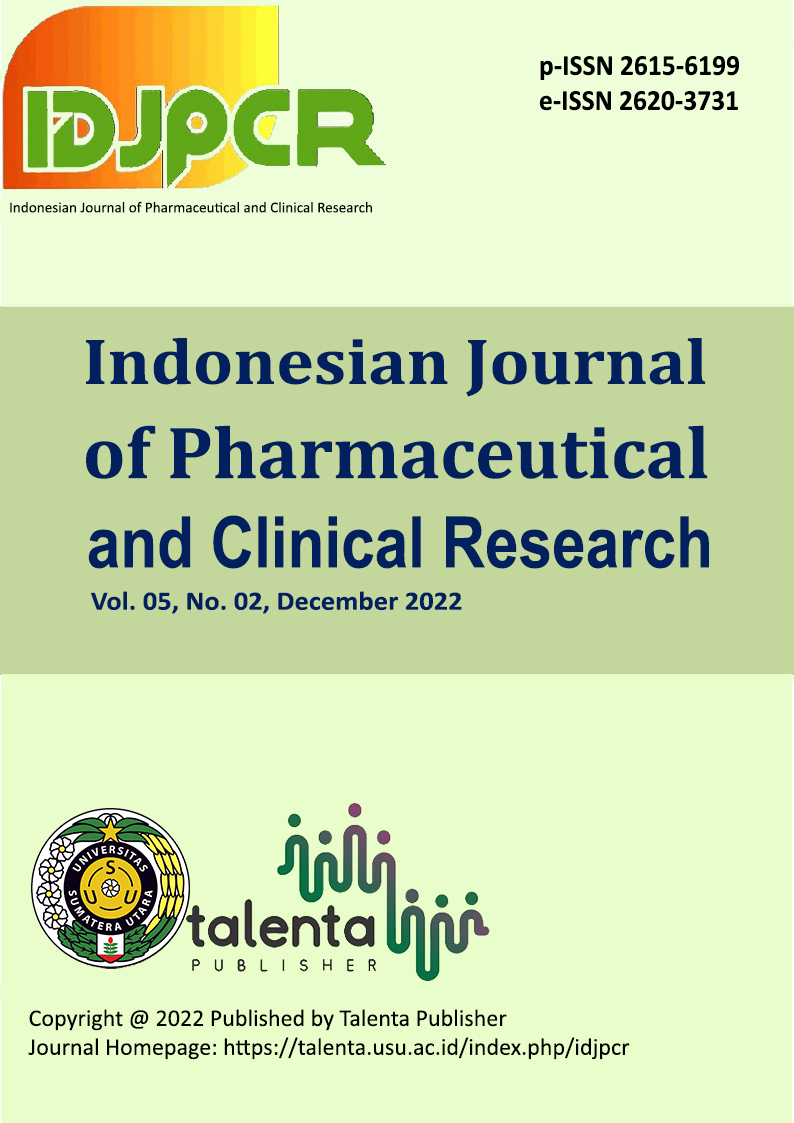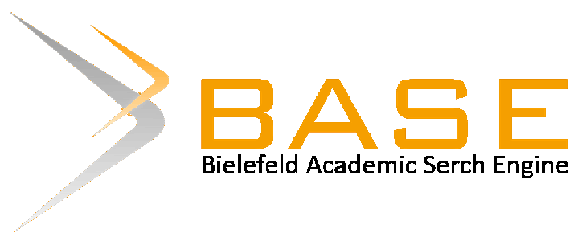Evaluation of Ethanol Extract of Red Algae (Kappaphycus Alvarezii Doty): Total Phenolic and Flavonoid Content
DOI:
https://doi.org/10.32734/idjpcr.v5i2.8871Keywords:
Red Algae, characterization, soxhletation.Abstract
This study aims to determine the characterization of red algae simplicia and the amount of yield obtained from the manufacture of red algae ethanol extract using the soxhletation method. Red algae were taken from Banggai Islands Regency, South Sulawesi and processed into dry simplicia and characterized by macroscopic examination, determination of water content, content of water soluble extract and ethanol, total ash content and acid insoluble ash content. Simplicia was extracted using 96% ethanol solvent by soxhletation method and calculated the amount of yield obtained. Macroscopic observation of red algae simplicia obtained a brown coarse powder accompanied by a distinctive taste and odor. Determination of the water content of simplicia obtained 7.21%, water soluble extract content 31.54%, ethanol soluble extract content 17.27%, total ash content 33, 96% and 11.42% acid insoluble ash content. The ethanolic extract of red algae using the soxhletation method was obtained as much as 68.92 grams with a total extract yield of 13.78%. Based on the results of the study, it can be concluded that the simplicia characterization of red algae meets the requirements and has a large extract yield.
Downloads
References
Irma, V., Dosen, S., Studi, P., Perkebunan, B., Sawit, K., Kelapa, P., Citra, S., & Edukasi -Bekasi, W. (2015). Pemanfaatan Berbagai Jenis Bahan Organik Sebagai Mulsa Untuk Pengendalian Gulma Di Areal Budidaya Tanaman. Jurnal Citra Widya Edukasi, VII(2), 56–62.
Anggadiredja, T., Zatnika, A., Purwoto, H., Dan Istini, S. (2010). Rumput Laut. Jakarta: Penerbit Penebar Swadaya. Halaman 14-19.
Winarno, F. G. 1990. Teknologi Pengolahan Rumput Laut. Jakarta : Sinar Pustaka Harapan.
Doty, M.S., (1987)., The Production And Uses Of Eucheuma In Case Studies Of Seven Commercial Seaweed Reosurces., M.S. Doty, J.F Cody And B. Santelices (Eds). FAO Fisheries Technical Paper.
Dawes, C. J. 1981. Marine Botany. John Wiley & Sons, Inc., New York.
Suparmi And A. Sahri, “Mengenal Potensi Rumput Laut : Kajian Pemanfaatan Sumber Daya Rumput Laut Dari Aspek Industri Dan Kesehatan,†Sultan Agung, Vol. XLIV, No. 118, Pp. 95–116, 2009.
[ Sudevan, S., Paramasivam, R., Arts, N., Vijayarghavan, R., & Arts, N. (2014). Study On Metabolic Compounds Of Kappaphycus Alvarezii And Its In-Vitro Analysis Of Anti-Inflammatory Activity . Int.J.Curr.Res.Aca.Rev. 2(10):157-166.
Kumar, K. S., Ganesan, K., & Rao, P. V. S. (2008). Antioxidant potential of solvent extracts of Kappaphycus alvarezii ( Doty ) Doty – An edible seaweed. 107, 289–295.
Fayaz, M., Namitha, K. K., Murthy, K. N. C., Swamy, M. M., Sarada, R., Khanam, S., Subbarao, P. V., & Ravishankar, G. A. (2005). Chemical composition, iron bioavailability, and antioxidant activity of Kappaphycus alvarezzi (Doty). Journal of Agricultural and Food Chemistry, 53(3), 792–797.
Tominaga, K., Hongo, N., Karato, M., & Yamashita, E. (2012). Cosmetic benefits of astaxanthin on humans subjects *. 59(1), 43–47.
Morton DW, A.-K. S. (2013). Cosmeceuticals Derived from Bioactive Substances Found in Marine Algae. Oceanography: Open Access, 01(02), 1–11.
Depkes RI, 1986, Sediaan Galenik, 2 &10, Departemen Kesehatan RI, Jakarta.
Puspitasari, A. D., & Wulandari, R. L. (2017). Aktivitas Antioksidan dan Penetapan Kadar Flavonoid Total Ekstrak Etil Asetat Daun Kersen ( Muntingia calabura ). 04(02), 167–175.
Depkes RI. (1995). Materia Medika Indonesia. Jilid VI. Jakarta: Departemen Kesehatan RI. Halaman 297-326, 333-340.
Departemen Kesehatan Republik Indonesia. (2017). Farmakope Herbal Indonesia. Edisi II. Jakarta: Direktorat Jenderal Pengawasan Obat Dan Makanan. Halaman 526, 528.
WHO. 1998. The World Health Organization Quality Of Life Assesment (WHOQOL): Development And General Psychometric Properties. Soc. Sci. Med Vol. 46, No 12, Pp 1569-1585. Great Britain
Duraisamy, P., S, K., Ram Vinod, A., & Kumar V, D. R. (2021). Preparation and Evaluation of Antioxidant, Antimicrobial Activity of Seaweed (Kappaphycus alvarezii) based Herbal Hair Oil Formulation. Journal of University of Shanghai for Science and Technology, 23(08), 314–325.
Aslan, L.M. (1999). Budidaya Rumput Laut. Yogyakarta: Penerbit Kanisius.
World Health Organization. (1992). Quality Control Methods For Medicinal Plant Materials. WHO/PHARM/92.559. Geneva: Halaman 26-27.
Hardoko. (2007). Studi Penurunan Glukosa Darah Diabet dengan Konsumsi Rumput Laut Eucheuma cottonii. Studi Penurunan Glukosa Darah Diabet Dengan Konsumsi Rumput Laut Eucheuma Cottonii, 9(1), 116–124.
Wardaningrum, R. Y. (2019). Perbandingan Aktivitas Antioksidan Ekstrak Etanol Terpurifikasi Ubi Jalar Ungu (Ipomoea Batatas .L) Dengan Vitamin E. Artikel.
Downloads
Published
How to Cite
Issue
Section
License
Copyright (c) 2022 Indonesian Journal of Pharmaceutical and Clinical Research

This work is licensed under a Creative Commons Attribution-ShareAlike 4.0 International License.
The Authors submitting a manuscript do so on the understanding that if accepted for publication, copyright of the article shall be assigned to Indonesian Journal of Pharmaceutical and Clinical Research (IDJPCR) and Faculty of Pharmacy as well as TALENTA Publisher Universitas Sumatera Utara as publisher of the journal.
Copyright encompasses exclusive rights to reproduce and deliver the article in all form and media. The reproduction of any part of this journal, its storage in databases and its transmission by any form or media, will be allowed only with a written permission from Indonesian Journal of Pharmaceutical and Clinical Research (IDJPCR).
The Copyright Transfer Form can be downloaded here.
The copyright form should be signed originally and sent to the Editorial Office in the form of original mail or scanned document.









